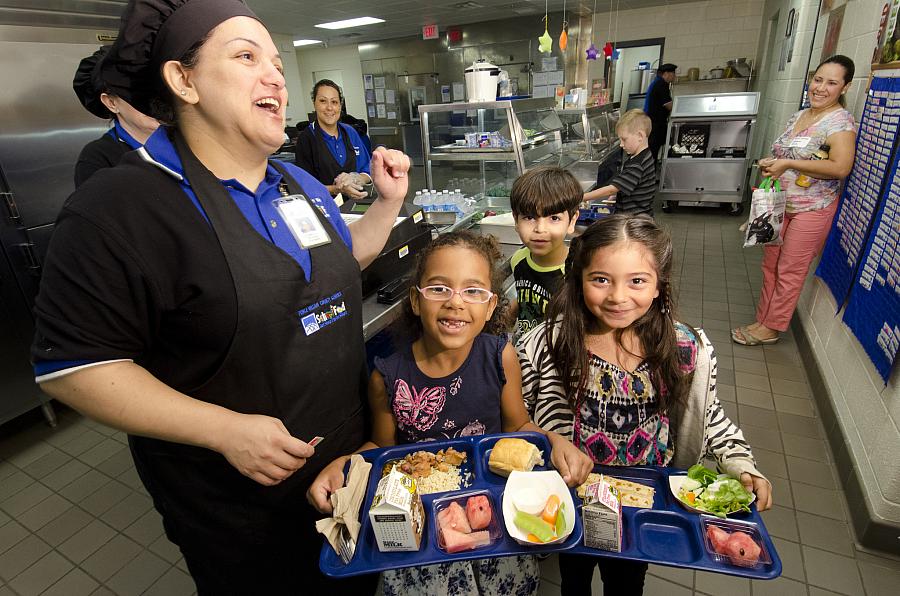Will new school lunch study lead media to lay off lunch line anecdotes?

In the midst of an ongoing child obesity epidemic, the Healthy Hunger-Free Kids Act was passed in 2010 with the goal of getting kids to eat healthier food at school. Students’ health and focus would improve and obesity rates would drop, supporters suggested.
It’s been a political food fight ever since.
On one side of the table are children’s health advocates who see the new standards — more fruits, veggies and whole grains, less salt — as an essential way to combat childhood obesity and associated disease. On the other side are school lunch workers and their trade group, who say the new rules are a recipe for tossed food and lost revenues. Anecdotes about kids trashing their uneaten lunches and the horrors of whole-wheat pasta have been standard in many press accounts.
But this week brought news of a break in the standoff, as the Senate Agriculture Committee voted in favor of a compromise that will keep the standards largely intact. The agreement dovetails nicely with newly published research that casts doubt on critics’ claims that the act is a culinary and financial disaster for schools — a theme widely echoed throughout the media.
Just a few months ago, The New York Times ran a questionably titled Sunday news analysis by Kate Murphy that painted a dire portrait of bloated trashcans and shrinking cafeteria revenues:
Food and nutrition directors at school districts nationwide say that their trashcans are overflowing while their cash register receipts are diminishing as children either toss out the healthier meals or opt to brown-bag it.
Murphy goes on to say “that 70 percent of school meal programs had taken a significant financial hit since the new mandates went into effect,” a figure attributed to the School Nutrition Association, a group that has persistently lobbied Congress to relax the new standards.
After reading pieces like this, readers could be forgiven for concluding the 2010 legislation was a well-intentioned policy disaster. Yet that’s not quite the case, as newly published research shows.
A study published earlier this month in JAMA Pediatrics takes a longitudinal look at how the new rules are affecting nutrition and participation in school lunch programs at one district of 7,200 kids in the Pacific Northwest.
Researchers rigorously tracked the items served, their nutrition value and school lunch participation for 16 months before the new standards went into place and for 15 months afterwards. If the new rules were leading to dramatic changes in the schools’ lunch programs, the study’s before-and-after design was designed to capture them.
Evidence of a rebellion was scarce. A JAMA Pediatrics editorial in the same issue succinctly outlines the study’s key findings:
This study had 2 major conclusions: (1) school meals selected by students following the implementation of the meal pattern changes were more nutritious while providing fewer calories and (2) meal participation rates did not change.
That last part is worth repeating: It turns out that the healthier standards didn’t really affect how many kids ate school lunch either. Participation only dropped one percentage point — from 47 to 46 percent — after the new standards went into effect.
The study is limited in that it’s based on one urban school district in Washington state. Rural districts may differ. But the figures mirror the national numbers. About 30.5 million kids received school lunches in 2015, and that’s pretty much unchanged since the beginning of the Great Recession in late 2007, as this trend line shows. There was actually a slight uptick in school lunch participation from 2014 to 2015, which is not what you’d expect if the new nutrition standards were fueling a nationwide brown-bag insurrection.
As the JAMA editorial notes, big changes in schools can be expected to generate some resistance. The first year can be rough, but other research also suggests that students typically adjust to the more nutritious fare — and so do cafeterias, willing or otherwise.
Despite the hullabaloo, this is starting to look like a case in which media-friendly anecdotes of toppling trash cans and lunch-lady laments got ahead of the data.
Related
Critics fight proposals to weaken healthier school lunch rules
Great Read: “How School Lunch Became the Latest Political Battleground,” by Nicholas Confessore, The New York Times
[Photo by USDA via Flickr.]

